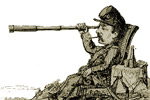|
USS Galena , a 950-ton ironclad gunboat, was built at Mystic,
Connecticut. Commissioned in April 1862 as the second of the U.S. Navy's
first three armored warships, she was immediately sent to Hampton Roads,
Virginia, to join the Navy's pioneer ironclad Monitor in
containing CSS Virginia . On 8 May, Galena attacked
enemy shore batteries on the James River, part of an intended drive up the
river to take Richmond, the Confederate capital city.
After the Virginia was destroyed, Galena and other
Union warships steamed up the James on 15 May to bombard Fort Darling,
located at Drewry's Bluff about eight miles below Richmond. In a sharp
action, Confederate gunners badly damaged Galena, killing twelve
of her crew and demonstrating the inadequacy of her relatively thin iron
armor. Despite her injuries, the ship remained in the James River area
through the next four months, shelling enemy shore positions on several
occasions in support of General McClellan's army during the flow and ebb
of its campaign on the Virginia Peninsula. After Galena left the
James in September 1862, she was stationed in Hampton Roads until May
1863, when she went to Philadelphia for repairs and alterations.
Recommissioned in February 1864, Galena had been stripped of
her iron plating, given a heavier gun battery and enlarged sail rig. Now a
conventional unarmored steam warship, in May she joined the West Gulf
Blockading Squadron's pending assault on Mobile Bay, Alabama. She was one
of the ships that ran past the Bay's defending Fort Morgan on the morning
of 5 August 1864. During that action, she assisted USS Oneida to
safety after that ship was disabled by Confederate gunfire. Later in the
month, Galena took part in the siege that led to Fort Morgan's
surrender.
Galena served in the East Gulf Blockading Squadron in
September-November 1864. After four months of shipyard repairs, she served
on Virginia's James and Nansemond Rivers through the end of the Civil War.
She decommissioned in June 1865 and was thereafter inactive except for a
brief time in the spring of 1869. USS Galena was broken up in
1872 at the Norfolk Navy Yard, where a new and somewhat larger Galena
was built under the administrative fiction of repairing the original.
|
|
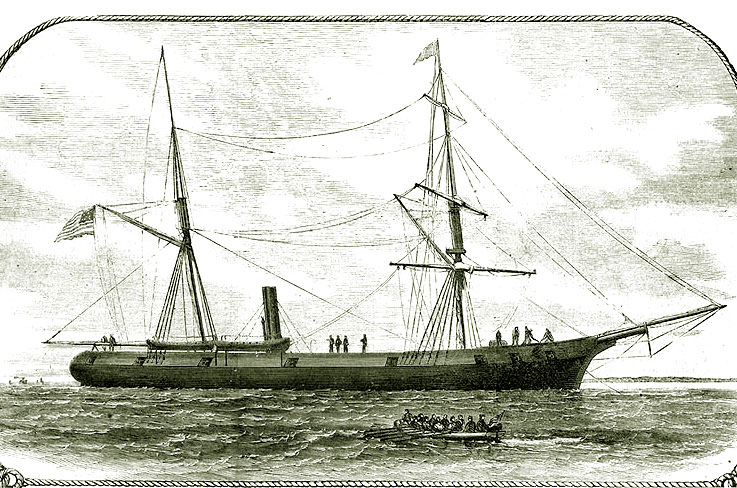
Line engraving, published in "Harper's Weekly", 1862
Depicting the ship as she appeared when first completed, with a two-masted schooner rig.
|
|
|
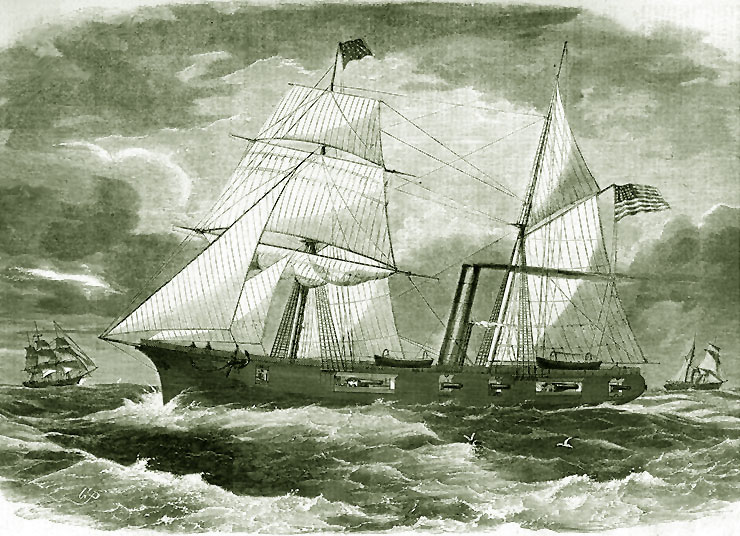
Line engraving published in "Harper's Weekly", July-December 1861
while the ship was under construction at Mystic, Connecticut.
(Details of this depiction are inaccurate, especially the elongated gun ports shown fore and aft of the smokestack.)
|
|
|

Wash drawing by R.G. Skerrett, 1898
Depicting the ship as she
appeared while serving on the James River, Virginia, circa mid-1862.
|
|
|
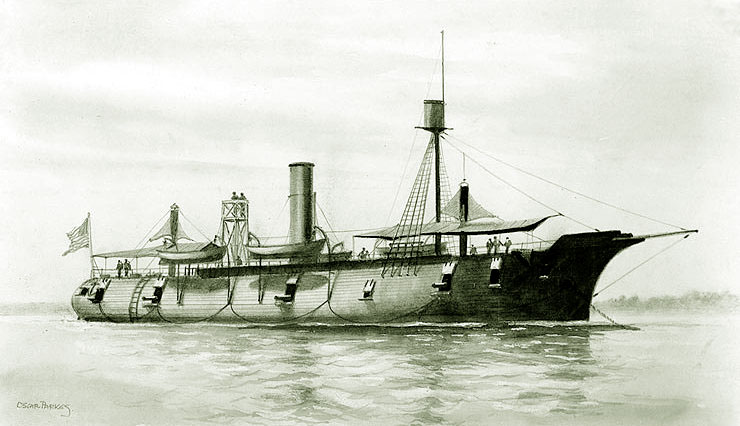
Watercolor by Oscar Parkes
Depicting the ship as she appeared in
mid-1862, while serving on the James River, Virginia.
|
|
|
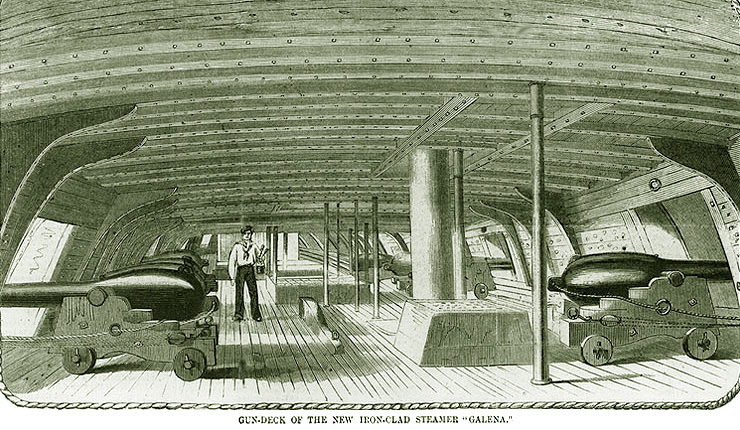
Line engraving, published in "Harper's Weekly", 1862
Depicting the ship's gun deck as it appeared when she was first completed.
|
|
|

Photograph looking forward along the ship's port side.
Taken shortly after
her 15 May 1862 action with
Confederate batteries at Drewry's Bluff, on the
James River, Virginia.
(Among the items visible are the muzzles of
two of Galena's IX-inch Dahlgren smoothbore guns; her unique
horizontally-laid interlocking iron side armor; armored gunport shutters;
boat davits; members of her crew; and at least one plugged hole from enemy
shot (near the waterline in bottom left center).
|
|
|

Photograph taken on board by Matthew Brady, shortly after
the 15 May
1862 action with Confederate batteries at Drewry's Bluff, Virginia.
(This view looks forward on the starboard side of the spar deck, and
shows holes in Galena's smokestack (in left center) made by
Confederate cannon fire. Among the other items seen are boat davits,
canvas windsails, the elevated wooden conning platform and the lookout
position on the foremast.)
|
|
|
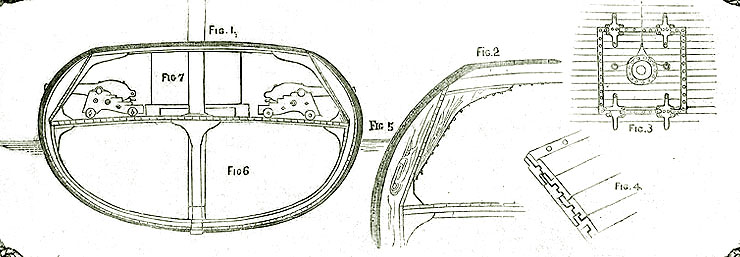
Line engraving, published in "Harper's Weekly", 1862
depicting the
ship's midship's hull section, the arrangement of her horizontally-laid
interlocking side armor, and one of her armored gun ports.
| |
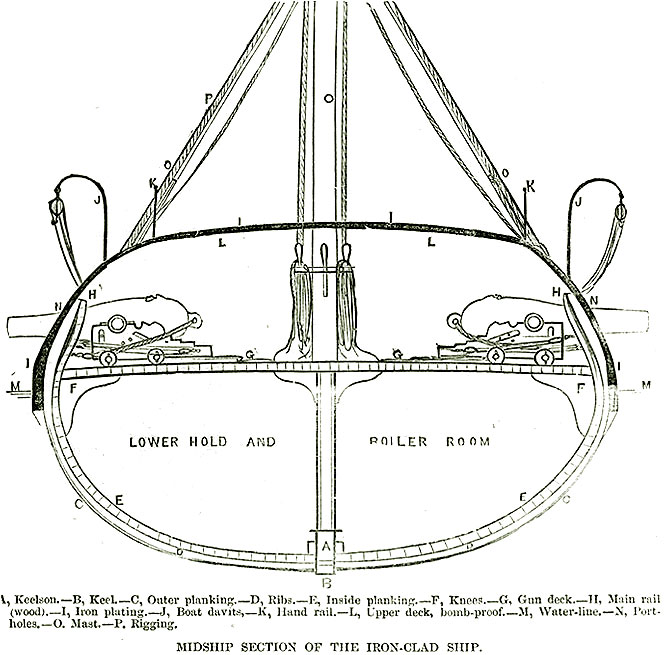
Line engraving published in "Harper's Weekly", July-December
1861
depicting the ship's hull section amidships. She was then under
construction at Mystic, Connecticut.
|
|
|


